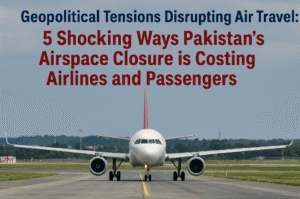Geopolitical Tensions Disrupting Air Travel: 5 Shocking Ways Pakistan’s Airspace Closure is Costing Airlines and Passengers
The closure of Pakistan’s airspace to Indian carriers, prompted by rising tensions in Kashmir, has severely disrupted global air travel. Indian flights to Europe, North America, and Central Asia now face costly detours, increasing flight times and operational costs, with some routes suspended altogether. Passengers suffer from missed connections, extended travel times, and health concerns due to cramped cabins. Low-cost carriers like IndiGo are particularly hard-hit, as their narrow-body jets cannot handle the redirected long-haul routes.
The economic toll of rerouting flights is significant, and while diplomatic resolutions could reopen airspace, the aviation industry is left to adjust in the face of geopolitical instability. This situation highlights how regional conflicts can disrupt global aviation and impact travelers and airlines alike.

Geopolitical Tensions Disrupting Air Travel: 5 Shocking Ways Pakistan’s Airspace Closure is Costing Airlines and Passengers
A recent closure of Pakistani airspace to Indian carriers has sent ripples across global aviation, forcing airlines to adopt costly detours, suspend routes, and grapple with operational headaches. The move, a response to escalating India-Pakistan tensions following an attack in Kashmir, underscores how geopolitics can abruptly alter the aviation landscape—with real consequences for airlines and passengers alike.
The Reroute Ripple Effect
Indian flights to Europe, North America, and Central Asia now face hours-long diversions, as they bypass Pakistan by swinging south over the Arabian Sea or threading through alternative corridors. For long-haul routes, this has meant:
- Extended Flight Times: A Delhi-Chicago trip now takes 18+ hours with a fuel stop in Vienna, up from 15 hours nonstop. Flights to San Francisco stretch beyond 20 hours.
- Suspended Services: Budget carrier IndiGo halted flights to Tashkent and Almaty, as its Airbus A320s lack the range for the redirected paths.
- Operational Costs: Detours burn extra fuel—Air India’s nonstop Delhi-Toronto flight now consumes 2 additional hours of flying, translating to thousands in added costs per trip.
Passenger Pain Points
Travelers face a cascade of disruptions:
- Missed Connections: Fuel stops risk misaligned layovers. A Delhi-Chicago flight stopping in Vienna could strand passengers if onward flights depart before arrival.
- Health and Comfort: Extended time in cramped cabins raises concerns about traveler well-being, particularly on ultra-long-haul routes.
- Uncertainty: Airlines like SpiceJet and IndiGo urge passengers to monitor schedules, as routes face last-minute adjustments.
Budget Carriers Hit Hardest
While Air India absorbs costs with fuel stops, low-cost airlines lack such flexibility. IndiGo’s suspension of Central Asian routes highlights a harsh reality: narrow-body jets, the backbone of budget travel, are ill-equipped for elongated routes. This could stifle India’s ambitions to expand as a global aviation hub, particularly for regional connectivity.
Echoes of Past Conflicts
The situation mirrors 2022’s Russia-Ukraine crisis, which forced Finnair and others to abandon lucrative Siberian shortcuts to Asia, inflating costs and flight times. Similarly, Indian carriers now face a “new normal” of circuitous paths, with no quick resolution in sight.
The Bigger Picture
- Economic Toll: Rerouting costs airlines millions annually in fuel, crew hours, and maintenance. These expenses may eventually trickle down to passengers via higher fares.
- Diplomatic Gridlock: Reopening airspace hinges on de-escalation—a complex prospect given the Kashmir dispute’s decades-long history.
- Aviation Adaptation: Airlines might pivot to larger aircraft or alternative hubs, but such shifts require time and investment.
Looking Ahead
While Air India emphasizes passenger safety, the long-term solution lies beyond aviation. Diplomatic efforts to ease tensions could restore efficient flight paths, but until then, airlines and travelers must brace for turbulence. For global aviation, this episode is a stark reminder: in an interconnected world, political strife doesn’t just shape borders—it reshapes the skies.
The closure serves as a case study in how regional conflicts can have global repercussions, transforming routine flights into logistical marathons. As airlines navigate these challenges, passengers are left hoping for calm on the ground to restore sanity in the air.
You must be logged in to post a comment.